By Catherine James
These heartbreaking pictures reveal a little-reported tragedy of the fighting in Afghanistan – the helpless babies left orphaned or motherless by the conflict.
The battle against the Taliban has left a deadly legacy for Helmand's children of war: babies without mothers and children so malnourished they are at risk of dying.
MailOnline visited a hospital treating children and civilians who have been hit by improvised explosive devices or who have been prevented from getting basic healthcare by the insurgency.
We found babies and children who have either lost their mothers because of the war, or who are now at risk of death for want of proper nourishment.
Tiny Ehsanullah is nine months old yet resembles a newborn. His mother bled to death when he was two days old.
He is one of the forgotten victims of the vicious wave of violence sweeping Afghanistan, which culminated in a Taliban attack on Camp Bastion this weekend. With the insurgency still a depressingly potent force, it is the Afghan civilian population that is bearing the brunt of its violence.
It is only days since the last British troops left Afghanistan, at a time when civilian casualties are up by a quarter.
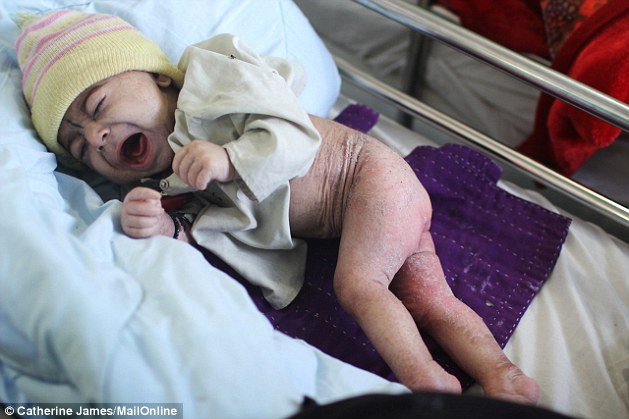
Tiny and alone: Ehsanullah, aged nine months, has lost his mother because the insurgency meant she could not be treated properly. Now he is in Boost Hospital in Lashkar Gah, Helmand where he is being treated for malnourishment. (Photo: Catherine James/MailOnline)

Trying to feed: Ehsanullah's mother died when he was two days' old because she began bleeding from the womb and Afghan forces refused to let her pass to go to hospital. (Photo: Catherine James/MailOnline)
The number of civilian casualties this year is up by a quarter, with 4853 deaths and injuries from January to September compared to the same period last year.
But not all the casualties of the war are from bullets or guns.
Unicef warns of an epidemic of motherless children and babies dying in childbirth. Afghanistan is one of the world’s most dangerous places for women to have children.
For 100,000 births, 460 women will die in childbirth or during pregnancy.
Ehsanullah's mother died as an indirect result of the fighting – because the Afghan National Army simply wouldn't grant her family access to the hospital road as she lay dying in their car.
He was two days old when his 17-year-old mother began to hemorrhage from her womb. The pregnancy and home-birth had gone smoothly enough, but when the bleeding began, Ehsanullah's father decided it was too serious to treat at home.
It was 2am. The roads were clear, and with the local medical clinic only a 15-minute drive from their house in Maiwand, a village in the southern Afghanistan province of Helmand, help was not far.
But at 4am, they were still in the car – and Ehsanullah's mother was dead. They had barely driven outside their village when Afghan national security forces stopped them.
'They stopped our car from far off,' Ehsanullah's grandmother said. 'One of our men approached them to say that we had a patient but they didn't let us go. Maybe they were afraid that he was not telling the truth because we were coming from the village.'
Unwilling to risk being shot at, they waited in the car as Ehsanullah's mother bled to death.
'We were stopped for about two hours because of the ongoing conflict. Perhaps they thought we were going to help the insurgents or they thought it was not safe. But they would not let us pass. Eventually we turned back and went home with her dead body,' his grandmother said.
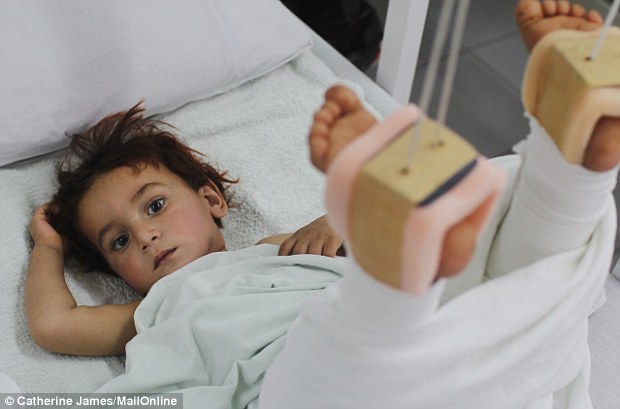
Damaged by warfare: Azizullah, aged just two, is from Baghran, a district controlled by the Taliban in north Helmand and where children fall victim to weaponry left behind. (Photo: Catherine James/MailOnline)

Deadly legacy: Muzlifa, aged 14, was injured by an improvised explosive device hidden in the ground near her home in Mousakala, in the north of Helmand province. (Photo: Catherine James/MailOnline)
The young mother will not be counted as a civilian casualty of war. But like so many others never heard of, her life was cut short and her son's life upended as a result of the conflict between Afghanistan's security forces and militants, while Western nations have withdrawn and declared the battle over for their armies.
But in addition to the acute maternal mortality rate, children are facing a battle to survive simply through lack of food and nutrients.
Mark Bowden, a UN humanitarian coordinator in Kabul, explained that malnourishment is also one of the biggest issues facing children in Afghanistan.
He said that 1.2 million children there are 'acutely malnourished' - with half a million of them are under five years old. Malnutrition is the one of the leading causes of deaths of children under five in the country, responsible for around one-third of deaths in this age group.
Nine months after his mother's death, Ehsanullah is in hospital receiving treatment for severe malnourishment. It was not until he developed multiple secondary infections that his family scraped together enough money to take him for medical treatment to the hospital with a dedicated ward for malnourished children, supported by Medecins Sans Frontiers in the capital of Helmand province, Lashkar Gah.
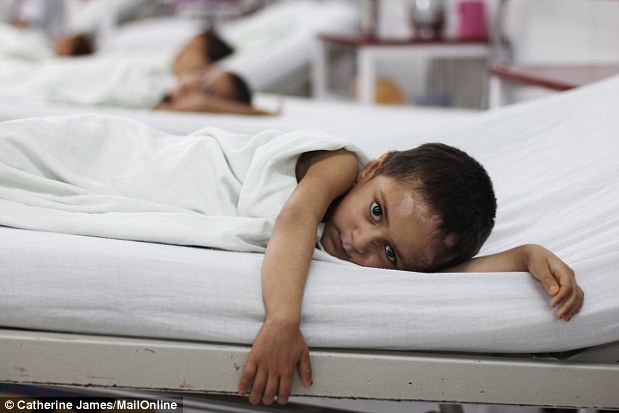
Alone: Farhad, aged three, a casualty receiving treatment in an emergency hospital in Lashkar Gah. (Photo: Catherine James/MailOnline)
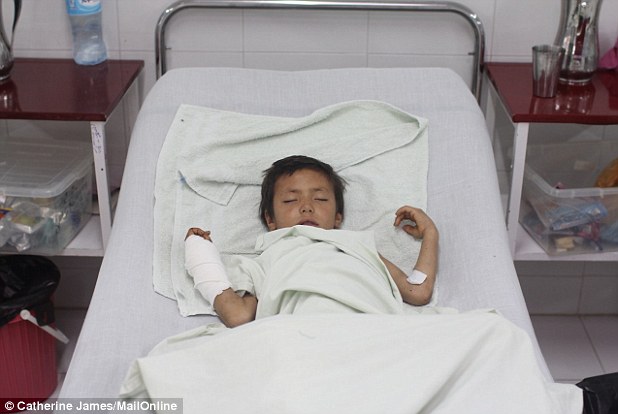
Six-year-old Rahmatullah is one of many children who outnumber women in the emergency hospital. (Photo: Catherine James/MailOnline)
Having been fed only dry milk and biscuits for most of his first year of life, the doctors said Ehsanullah had developed severe skin infections and wasting of the muscle. But he was on the way to recovery.
'He has improved already quite a bit,' said Dr Nasim, the Nurse Supervisor in Boost Hospital's Therapeutic Feeding Centre. 'He is crying aloud now – that is a sign he has gained strength.' Most malnourished children brought in for treatment are too weak to cry, he added.
The UN Assistance Mission in Afghanistan (UNAMA) said 2014 has seen the highest number of civilian casualties since 2009. In its mid-year report on the topic, UNAMA documented 4,853 civilian casualties in the first six months of this year – a 24 per cent increase on the same period for 2013. Of the total, 1,564 civilians were killed and 3,289 civilians were injured.
In a country where an estimated 47 percent of the population is under the age of 14, according to UN Data, the number of children affected by the conflict is similarly high.
For only the first six months of 2014, UNAMA recorded a 34 percent increase of child civilian casualties to 1,071, including 295 killed and 776 injured.
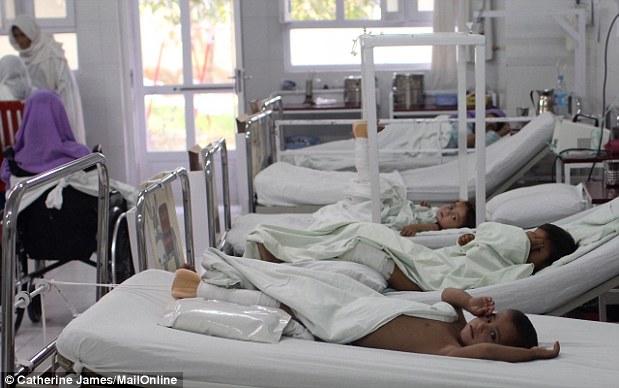
Lost limbs: Ismail, aged five, in the foreground. The children share a ward with women. (Photo: Catherine James/MailOnline)
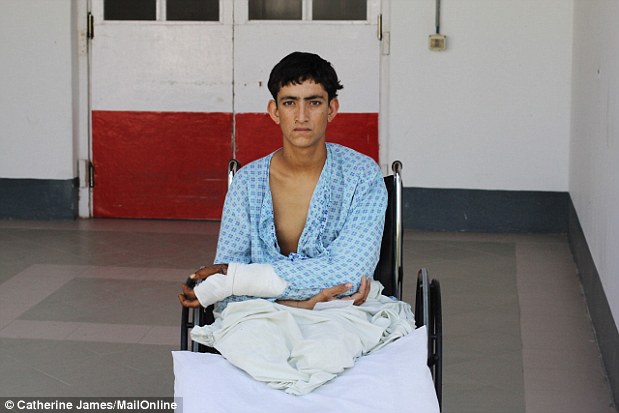
Innocent victim: Razimamud, 17, lost his legs and injured his right side after stepping on an improvised explosive device left behind in the battle against the insurgency. His father was killed four years ago by an IED. (Photo: Catherine James/MailOnline)
Extend these figures to September and the number of deaths rocket, according to Bowden.
'From January to September this year, around 7965 Afghan civilians have been killed by clashes between government forces and militants,' said Bowden.
'But not all deaths or injuries stemming from the war will be counted in the toll. Many go unreported, or are not regarded as a direct consequence.'
Next door to the MSF-supported Boost Hospital is a second hospital solely for casualties of war run by Emergency, an Italian non-government organisation.
The hospital does not differentiate between civilians and combatants, so it does not keep a record of how many civilians compared to combatants are being injured. However, Dimitra Giannakopoulou, the medical coordinator at Emergency Hospital said: 'We are treating a lot more women and children.'
In its first ten years of existence, the hospital had around 70 beds. But last June, as the casualties climbed, Emergency had to add another 30 beds.
'Sangin was on fire,' Giannakopoulou said, referring to the district about 1.5 hours' drive north-east of Lashkar Gah where the fiercest fighting was taking place over the summer.
'We had to increase the number of beds we have by about 30. We got rid of the children's playroom and the pharmacy to make space for them,' she said.
On the day MailOnline visited the hospital, there are more children than women in their shared ward.
Muzlifa, 14, recently arrived at the hospital. The shrapnel cuts were evident across her swollen face as she explained from her bed that her wounds came from an IED (an improvised explosive device popular with militants) hidden in the ground near her home in Mousakala, a district north of Sangin. She did not know the extent of her injuries and the hospital staff declined to disclose more information.
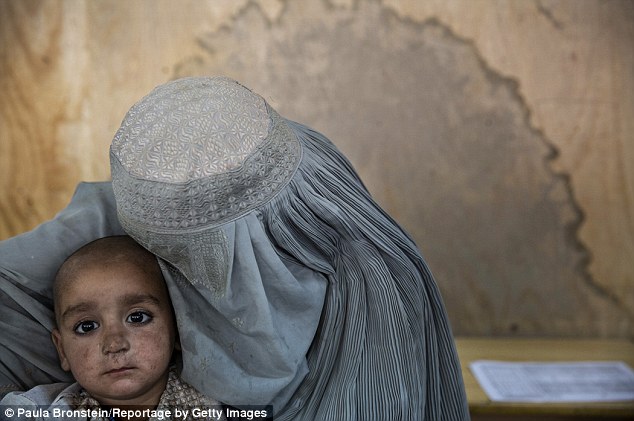
An Afghan mother holds her son, who is being treated for malnutrition at the Boost Hospital. (Photo: Paula Bronstein/Getty Images)
Another teenager Razimahmud Jahan lost his legs and damaged the left side of his body two weeks earlier to an IED. Four years ago, an IED killed his father.
Although he looks barely old enough to be 15, Razimahmud says he is 17 and was part of the Afghan Local Police (ALP) force, like his father before him.
Razimamud nearly died after he stepped on the landmine while patrolling with five other ALP officers in Gereshk district, about 1 hour north of Lashkar Gah.
When asked how he felt about the future in the face of his injuries, Razimamud does not mention himself.
'I am just feeling sorry for the civilian people because all of them are getting injured or dying or having amputations because of the war,' he says.
'I want to help, but I don't have any legs so I cannot help anymore.'
As the eldest son of six children, Razimamud felt responsible for his family after their father died, so he sought out work at an early age. His mother has since married his uncle – his father's brother – so he is confident of his uncle's support for him.
'When I am discharged from hospital, I will go home. My father [uncle] and brother [9 years old] will do something to help me,' he says.
Razimamund's story is not uncommon. In a year that has already seen 4,634 of the Afghan security forces die – a record number since the US-led war began in 2001 – the number of injured and permanently-disabled personnel is, anecdotally, equally high.
Such statistics threaten the morale of the country's fledgling armed forces, according to the Helmand police chief Brig. Gen. Juma Gul Himat.
But despite the lack of equipment and experience compared to the British military and US forces who were based in the province until last month, the Afghans have managed to retain control of most of the parts secured in the 13-year offensive against the militants.
Britain's combat role ended in Afghanistan when the last troops left Camp Bastion in late October. It was part of a transition that will see the U.S and Nato combat mission end on December 31.
The base was handed over to Afghan troops after a war that cost £20billion and the lives of 453 British personnel.
For Afghan civilians, however, the impact of the war continues, with the conflict beginning to overturn their daily lives.



